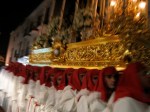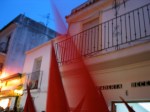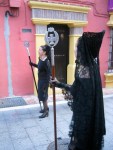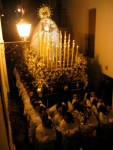Semana Santa – Easter Spanish Style

Here in the UK, you know when Easter is coming because, from around January time, they start stocking mini eggs, cream eggs and progressively greater and greater stocks of foil covered novelty eggs, bunnies and other such creatures until the day itself, after which time the egg prices are cut savagely before picnic and gardening gear replaces its space on the shelves. This is all very well, but when celebrated through an egg count alone, Easter becomes merely an excuse to take a few days off work, and an attempted resistance to the chocolate influx all around. By contrast, in Spain, and in particular in the region of Andalucia, the festival of Easter, and in particular this week – Holy Week (“Semana Santa”) – brings with it a uniquely special feeling of celebration, family and spirituality. I am not trying to say that every household around the world should celebrate the Christian story when the Easter festival comes along. Nonetheless, there is something deeply emotional, integral and raw about the outward manifestation of the Catholic celebrations of the Easter story in Spain, and I can’t help but wish that these celebrations were mirrored elsewhere.
After a decade of attending Spain’s lavish Easter celebrations, the Spanish Semana Santa festivities have become emblematic, to my mind, of Easter time. The celebrations largely comprise long processions of brotherhoods (“hermandades”) from a town’s local churches, each of whom carry “pasos” or “tronos” – lifelike wood or plaster sculptures of individual scenes of the events that happened between Jesus’ arrest and his burial – throughout the town. The tronos, which are usually huge, golden, elaborately carved constructions topped with candles aplenty, are then physically carried on the necks of costaleros. The tronos are accompanied by nazareños – penitents who, most strikingly of all, are usually to be found wearing conical hats with covered faces called “capirotes”, and by brass and military bands. What with the moving emotional accompaniment of the bands, and the vast numbers of nazareños and costaleros making up the parade, carrying candles, often walking on bare feet to demonstrate penitence and faith, and the pasos, glowing in candlelight, swaying from side to side to the rhythm of the marching costaleros, these parades make for stunning viewing. And what is perhaps even more stunning, is the way in which these parades bring communities together – hundreds of families, couples, tourists and visitors old and young alike crowd the streets of Spain to see these parades – and involved in the parades themselves are people of all ages. How beautiful to see these processions taken so seriously, especially by teenagers – in the UK they’d most likely be looting the shops for Easter Eggs.
I leave you, without further ado, with a selection of my photos from the parades I have seen over the years, largely in Marbella. For the most spectacular parades of all, Seville is the place to go, but I have not yet had that fortune. Nevertheless, the processions of Semana Santa have remained a constant inspiration to me, and this week, I will feature a number of my art works which have taken their inspiration directly from these stunning parades. Hasta lugeo.
- Marbella’s startlingly realistic wax effigy of the dead Christ, paraded on Viernes Santo
© Nicholas de Lacy-Brown and The Daily Norm, 2005-2012. Unauthorized use and/or duplication of the material, whether written work or artwork/ photographs, included within The Daily Norm without express and written permission from The Daily Norm’s author and/or owner is strictly prohibited. Excerpts and links may be used, provided that full and clear credit is given to Nicholas de Lacy-Brown and The Daily Norm with appropriate and specific direction to the original content.






































































Trackbacks & Pingbacks